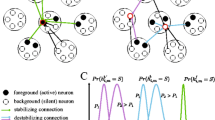Abstract
This paper presents a continuous-time model of Autoassociative Neural Memories (ANMs) which correspond to a modified version of pseudoinverse-type ANMs. This ANM model is derived from minimizing the energy function for a modular neural network. Through the eigendecomposition of the connection matrix, we show that the dynamical properties of the ANM are qualitatively different in the two state subspaces: a pattern-subspace and a noise-subspace. The proposed ANM has a distinctive feature in the noise-subspace dynamics. The size of basins of attraction can be varied by controlling the contribution of the noise-subspace dynamics to the whole network. The first simulation confirms this attractive feature. In the second simulation, we investigate the performance robustness of the ANM for several kinds of correlated pattern sets. These simulation results confirm the usefulness of the proposed ANM.
Similar content being viewed by others
References
Hopfield, J. J.: Neural networks and physical systems with emergent collective computational abilities, Proc. Natl. Aca. Sci. U.S.A. 79 (1982), 2254–2558.
Kohonen, T.: Self-organization and associative memory (3rd ed.), Springer-Verlag, Berlin, 1989.
Amari, S: Neural theory of association and concept-formation, Biol. Cybern. 26 (1977), 175–185.
Hassoun, M. H. and Youssef, A. M.: High performance recording algorithm for Hopfield model associative memories, Optical Engineering 28 (1989), 46–54.
Telfer, B. and Casasent, D: Ho-Kashyap optical associative processors, Applied Optics 29 (1990), 1191–1202.
Kanter, I. and Sompoilnsky, H: Associative recall of memory without errors, Physical Review A 35 (1987), 380–392.
Ho, Y.-C. and Kashyap, R. L.: An algorithm for linear inequalities and its applications, IEEE Trans. on Electronic Computers EC-14 (1965), 683–688.
Tsutsumi, K: Cross-Coupled Hopfield Nets via generalized-delta-rule-based internetworks, Proc. of Int. Joint Conf. on Neural Networks (IJCNN90-San Diego) II (1990), 259–265.
Gorodnichy, D. O. and Reznik, A. M.: Increasing attraction of pseudo-inverse autoassociative networks, Neural Processing Letters 5 (1997), 121–125.
Tsutsumi, K: Higher degree error backpropagation in Cross-Coupled Hopfield Nets, Proc. of Int. Joint Conf. on Neural Networks (IJCNN91-Seattle) II (1991), 349–355.
Ozawa, S., Tsutsumi, K. and Baba, N.: An artificial modular neural network and its basic dynamical characteristics, Biol. Cybern. 78 (1998), 19–36.
Ikeda, K: A spurious-memory free associative memory system – hysteresis neurons and pseudoinverse matrix model, The Brain & Neural Networks (in Japanese) 3 (1996), 141–146.
Gorodnichy, D. O.: A way to improve error correction capability of Hopfield associative memory in the case of saturation, HELNET International Workshop on Neural Networks Proceedings (HELNET 94–95) I/II (1996), 198–212.
Kindo, T. and Kakeya, H.: A geometrical analysis of associative memory, Neural Networks 11 (1998), 39–51.
Ozawa, S., Tsutsumi, K. and Baba, N: Association performance of Cross-Coupled Hopfield Nets for correlated patterns, Proc. of Int. Joint Conf. on Neural Networks (IJCNN93-Nagoya) II (1993), 2335–2338.
Author information
Authors and Affiliations
Rights and permissions
About this article
Cite this article
Ozawa, S., Tsutsumi, K. & Baba, N. A Continuous-Time Model of Autoassociative Neural Memories Utilizing the Noise-Subspace Dynamics. Neural Processing Letters 10, 97–109 (1999). https://doi.org/10.1023/A:1018729317339
Issue Date:
DOI: https://doi.org/10.1023/A:1018729317339




